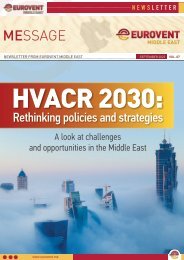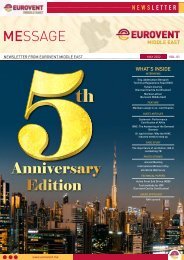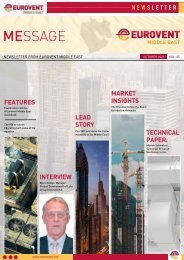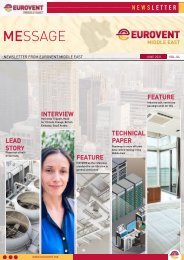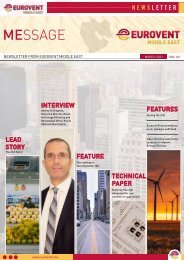EME Newsletter MEssage #01/2023
HVACR Industry news from Eurovent Middle East
HVACR Industry news from Eurovent Middle East
You also want an ePaper? Increase the reach of your titles
YUMPU automatically turns print PDFs into web optimized ePapers that Google loves.
NEWSLETTER<br />
TECHNICAL ARTICLE<br />
Rafael Van Eijcken<br />
Institute (CTI), has developed a<br />
certification program specifically for<br />
the thermal performance of factoryassembled<br />
open, and closed-circuit<br />
cooling towers. These program<br />
models consist of individual units<br />
with published thermal rating<br />
capacities and associated input fan<br />
power levels.<br />
Looking at the numbers<br />
Let us consider a typical example<br />
in the Middle East of an HVAC<br />
application that operates year-round<br />
with a load variation from 100%<br />
in summer to 75% in winter. The<br />
summer condition to cool 100 LPS<br />
from 40°C to 35°C at an ambient wet<br />
bulb temperature (WBT) of 32°C. In<br />
this case, the cooling capacity to be<br />
rejected would be 2093 KW.<br />
For this scenario, the selected<br />
cooling tower, which we can refer<br />
to as Cooling Tower A (CT-A), will<br />
have a length of 2585 mm, 5500<br />
mm wide and 3653 mm high with<br />
29 KW absorbed fan power and a 30<br />
KW installed fan motor. The overall<br />
sound power level of CT-A would be<br />
104 dB(A).<br />
Now, let us consider an undersized<br />
model Cooling Tower B (CT-B),<br />
which would only deliver 85% but<br />
with a lower initial cost than CT-A.<br />
Typically, this unit would be 15%<br />
smaller in physical size or have<br />
the same size as CT-A but with an<br />
absorbed fan power of only 20.1 KW<br />
Emmanuel Timothy<br />
with a 22 KW installed fan motor.<br />
The overall sound power level of<br />
the CT-B would be 102 dB(A).<br />
For 2093 KW, which has to be<br />
dissipated at WBT 32°C, CT-B will<br />
supply a 1.35°C warmer outlet<br />
than designed. Or it will deliver<br />
the design temperatures up to a<br />
WBT of 30.79°C only.<br />
For projects where undersized<br />
cooling towers are installed, which<br />
are also typically non-certified<br />
cooling towers, when customers<br />
face a shortage in capacity<br />
and contact that cooling tower<br />
manufacturer about the problems<br />
faced on site, the response will<br />
typically be that the supplied<br />
cooling tower is “correctly<br />
sized” and that the issue is most<br />
probably related to poor operation<br />
and maintenance. This risk is<br />
taken by some manufacturers in<br />
the belief that the customers will<br />
not make an effort to request and/<br />
or verify third-party certification<br />
documents, as their main priority<br />
is choosing a system with the<br />
lowest initial cost. Initially, the<br />
problems caused by an undersized<br />
cooling tower unit might be<br />
minimal until the project requires<br />
its full cooling load which may<br />
take several years. In time,<br />
however, the problem of capacity<br />
shortage will be aggravated and<br />
create serious problems onsite.<br />
Although the customer may be<br />
misled by small power savings<br />
on the fan motor KW for CT-B<br />
compared to CT-A, they may not<br />
be aware that such an undersized<br />
cooling tower will trigger extra<br />
work on the chiller by increased<br />
compressor lift linked to the 1.35°C<br />
warmer water supplied to the chiller<br />
by CT-B. This increased compressor<br />
work increases the chiller power<br />
consumption significantly during a<br />
year-round operation by more than<br />
6%. With the chiller compressor<br />
motor being a multiple of the CT<br />
fan motor, this situation causes<br />
significantly higher operational<br />
costs for the customer.<br />
Let us also look at the annual<br />
economic impact the customer<br />
will face with CT-A and CT-B if<br />
both cooling towers use variable<br />
frequency drives and run with a<br />
water concentration factor of 5<br />
cycles.<br />
The fan kWh requirement-based<br />
year-round operation for CT-A will<br />
be 55,540 kWh, and for CT-B, it<br />
will be only 50,800 kWh. However,<br />
looking at the electrical energy<br />
needed for the chiller, for CT-A, we<br />
need 1,114360 kWh, but for CT-B,<br />
the chiller requirement goes up to<br />
1,178,700 kWh, which is 6% more.<br />
Therefore, by adding the chiller and<br />
fan kWh the CT-B system still needs<br />
5% more electrical energy annually.<br />
A typical AED 0.38 fils/kWh cost will<br />
represent an annual operating cost<br />
of AED 22,648.00.<br />
In addition, CT-B will have more<br />
water consumption, as the chiller<br />
will need to work harder, and<br />
therefore more waste energy is<br />
dissipated, resulting in more water<br />
evaporating. Ultimately, the CT-B<br />
water consumption will be 300 m3<br />
[65,991.00 Imperial Gals] water<br />
more than CT-A. Considering the<br />
water rate at AED 4.6 fils/IG (plus<br />
the sewerage charges) this will add<br />
approximately another AED 4,500.00<br />
per year.<br />
Below is a chart illustrating the<br />
additional cost vs energy and water<br />
costs with a 3% year-on-inflation<br />
rate price increase.<br />
The total operating cost difference<br />
for water and electricity for<br />
the system with CT-B will be<br />
AED 27,148.00. This number is<br />
typically near to half of the first<br />
cost difference with CT-A. From<br />
this, it is clear that a small price<br />
advantage for CT-B melts away when<br />
considering energy and water costs<br />
Keep in mind<br />
Thus, it is essential to remember<br />
that value for money does not just<br />
come by looking at the first cost and<br />
mindlessly accepting manufacturer<br />
documents with self-declared<br />
thermal performance. A customer<br />
must be able to challenge such<br />
manufacturer declarations by<br />
questioning whether the thermal<br />
performance is Eurovent/CTI<br />
certified or insist on a performance<br />
field test (acceptance test)<br />
according to the Eurovent/CTI<br />
standards to confirm or verify the<br />
declared thermal performance.<br />
Only by insisting on a field<br />
performance test carried out by<br />
certified testing agencies, even<br />
with the additional cost, will the<br />
customer determine whether the<br />
cooling tower can provide the listed<br />
performance. However, suppose<br />
the results lead to a failed test. In<br />
that case, the customer’s misery<br />
will just begin, as this often leads to<br />
many unpleasant discussions with<br />
the manufacturer, often with no final<br />
resolution. Selecting a cooling tower<br />
which has Eurovent / CTI Certified<br />
Performance via either the third<br />
party or internal lab testing ensures<br />
the buyer before the purchase that<br />
they will not have higher operating<br />
costs due to underperformance.<br />
Certified thermal performance<br />
testing removes risk towards<br />
system economics and removes<br />
the guesswork. It also removes the<br />
problems of litigation, penalties and<br />
compensation should an already<br />
purchased product be found to<br />
underperform because it’s too late<br />
by then.<br />
Remember to look for the Eurovent<br />
/ CTI Certified Performance mark<br />
to ensure optimal cooling tower<br />
selection. Eurovent includes yearly<br />
factory certification conformity<br />
audits of the Cooling Tower<br />
manufacturer. At the end of the<br />
day, purchasing a Eurovent / CTI-<br />
Certified model ensures that the<br />
cooling tower will perform as<br />
specified. In all instances of thermal<br />
certification, the purchased model,<br />
or a model within the same line, will<br />
have been thoroughly inspected and<br />
tested by a Eurovent / CTI-licensed<br />
testing agency, and customers can<br />
rest assured that their system will<br />
operate as intended.<br />
www.eurovent.me SEPTEMBER JUNE <strong>2023</strong> 2022 VOL. 01 09






